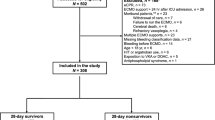Abstract
Purpose
Bleeding is a major complication of patients requiring extracorporeal membrane oxygenation (ECMO). Several risk factors have been identified; however, there remains a paucity of evidence for optimal management of anticoagulation and bleeding in ECMO patients.
Methods
A total of 255 patients required ECMO from January 1996 to December 2021 at a single institution. The Bleeding Academic Research Consortium (BARC) Score was used for defining actionable bleeding. Univariate and multivariate testing were used for outcome analysis. Kaplan-Meier survival curves were plotted for time-to-event analysis.
Results
Of the 255 patients, 147 patients had no actionable bleeding complications, while 108 had at least one actionable bleeding complication. Duration of support (p<0.001) and total number of transfusions (p<0.001) differed between the two groups significantly, with no significant difference in survival to discharge (p=0.894). On multivariate regression, significant predictors for actionable bleeding complications included diabetes (OR 2.01, p=0.03), precannulation hematocrit (OR 0.97, p<0.001), length of support (OR 1.00, p<0.001), use of warfarin (OR 2.28, p=0.03), and post-cardiotomy indication for ECMO (OR 0.77, p=0.02). The median time to first actionable bleeding complication after cannulation was 141.2 h. When stratified by indication for ECMO or type of ECMO circuit, there was a significant difference in time to first actionable bleeding complication (p=0.001, p=0.018).
Conclusions
Indication for ECMO and type of ECMO circuit both are predictive of timing to first actionable bleeding complication in our study. Further data are needed to reliably establish individualized anticoagulation strategies and bleeding management based on indication and circuit setup.




Similar content being viewed by others
References
Ali J, Vuylsteke A. Extracorporeal membrane oxygenation: indications, technique and contemporary outcomes. Heart. 2019;105:1437–43.
Treml B, Breitkopf R, Bukumirić Z, Bachler M, Boesch J, Rajsic S. ECMO predictors of mortality: a 10-year referral centre experience. Journal of clinical medicine. 2022;11:1224.
Aubron C, DePuydt J, Belon F, Bailey M, Schmidt M, Sheldrake J, et al. Predictive factors of bleeding events in adults undergoing extracorporeal membrane oxygenation. Ann Intensive Care. 2016;6:97.
Kalbhenn J, Zieger B. Bleeding during veno-venous ECMO: prevention and treatment. Front Med (Lausanne). 2022. https://doi.org/10.3389/fmed.20222.879579
Ried M, Sommerauer L, Lubnow M, Müller T, Philipp A, Lunz D, et al. Thoracic bleeding complications in patients with venovenous extracorporeal membrane oxygenation. Ann Thorac Surg. 2018;106:1668–74.
Werho DK, Pasquali SK, Yu S, Donohue J, Annich GM, Thiagarajan RR, et al. Hemorrhagic complications in pediatric cardiac patients on extracorporeal membrane oxygenation: an analysis of the Extracorporeal Life Support Organization Registry. Pediatr Crit Care Med. 2015;16:276-88.
Lansink-Hartgring AO, de Vries AJ, Droogh JM, van den Bergh WM. Hemorrhagic complications during extracorporeal membrane oxygenation–the role of anticoagulation and platelets. J Crit Care. 2019;1:239–43.
Mehran R, Rao SV, Bhatt DL, Gibson CM, Caixeta A, Eikelboom J, et al. Standardized bleeding definitions for cardiovascular clinical trials: a consensus report from the Bleeding Academic Research Consortium. Circulation. 2011;123:2736–47.
Ihaka R, Gentleman R. R: a language for data analysis and graphics. Journal of computational and graphical statistics. 1996;5:299–314.
Kanda Y. Investigation of the freely available easy-to-use software ‘EZR’for medical statistics. Bone Marrow Transplant. 2013;48:452–8.
ELSO. Registry of active ELSO centers using ECMO. 2022. https://www.elso.org/registry.aspx. Accessed Dec 29, 2022
McMichael AB, Ryerson LM, Ratano D, Fan E, Faraoni D, Annich GM. 2021 ELSO adult and pediatric anticoagulation guidelines. ASAIO J. 2021;68:303–10.
Krueger K, Schmutz A, Zieger B, Kalbhenn J. Venovenous extracorporeal membrane oxygenation with prophylactic subcutaneous anticoagulation only: an observational study in more than 60 patients. Artificial Organs. 2017;41:186–92.
Kurihara C, Walter JM, Karim A, Thakkar S, Saine M, Odell DD, et al. Feasibility of venovenous extracorporeal membrane oxygenation without systemic anticoagulation. Ann Thorac Surg. 2020;110:1209–15.
Carr ME. Diabetes mellitus: a hypercoagulable state. J Diabetes Complications. 2001;15:44–54.
Woerdeman J, van Duinkerken E, Wattjes MP, Barkhof F, Snoek FJ, Moll AC, et al. Proliferative retinopathy in type 1 diabetes is associated with cerebral microbleeds, which is part of generalized microangiopathy. Diabetes Care. 2014;37:1165–8.
Lip GY, Clementy N, Pierre B, Boyer M, Fauchier L. The impact of associated diabetic retinopathy on stroke and severe bleeding risk in diabetic patients with atrial fibrillation: Th e Loire Valley Atrial Fibrillation Project. Chest. 2015;147:1103–10.
ClinicalTrials.gov [Internet]. Bethesda (MD): National Library of Medicine (US). 2018 Oct 10. Identifier NCT04496362, Veno-venous Extracorporeal Membrane Oxygenation (VV-ECMO) heparin study; Available from: https://clinicaltrials.gov/ct2/show/NCT04496362. Accessed Dec 29, 2022
ClinicalTrials.gov [Internet]. Bethesda (MD): National Library of Medicine (US). 2022 Sep 1. Identifier NCT04273607, Anticoagulation-free VV ECMO for acute respiratory failure: a pilot safety and feasibility randomized clinical trial; Available from: https://clinicaltrials.gov/ct2/show/NCT04273607. Accessed Dec 29, 2022,
Funding
None.
Author information
Authors and Affiliations
Contributions
MM – conception, writing, editing, figures, tables, data collection, data analysis
DF – writing, editing, tables
DD – editing, supervision
DN – conception, editing, supervision, data collection
Corresponding author
Ethics declarations
Ethics approval
IRB/ERB Western University HSREB 109252.
Informed consent statement
Implied consent was obtained for all individuals involved in this study at the time of treatment initiation.
Conflict of interest
None.
Statement of human and animal rights
All procedures were in keeping with accordance of the ethical standards of our institutional committee.
Additional information
Publisher’s note
Springer Nature remains neutral with regard to jurisdictional claims in published maps and institutional affiliations.
Supplementary Information

ESM 1
ROC Curve for Multivariable Model of ECMO bleeding predictors. Receiver Operating Characteristics (ROC), ECMO: extracorporeal membrane oxygenation (PNG 20 kb)

ESM 2
Kaplan-Meier Curve for Time to Actionable Bleeding, grouped by ECMO indication, including only patients after 2014. ECMO: extracorporeal membrane oxygenation (PNG 47 kb)
Rights and permissions
Springer Nature or its licensor (e.g. a society or other partner) holds exclusive rights to this article under a publishing agreement with the author(s) or other rightsholder(s); author self-archiving of the accepted manuscript version of this article is solely governed by the terms of such publishing agreement and applicable law.
About this article
Cite this article
Malik, M.I., Fakim, D., Drullinksy, D. et al. Indication for ECMO predicts time to first actionable bleeding complication. Indian J Thorac Cardiovasc Surg 40, 177–183 (2024). https://doi.org/10.1007/s12055-023-01601-9
Received:
Revised:
Accepted:
Published:
Issue Date:
DOI: https://doi.org/10.1007/s12055-023-01601-9




